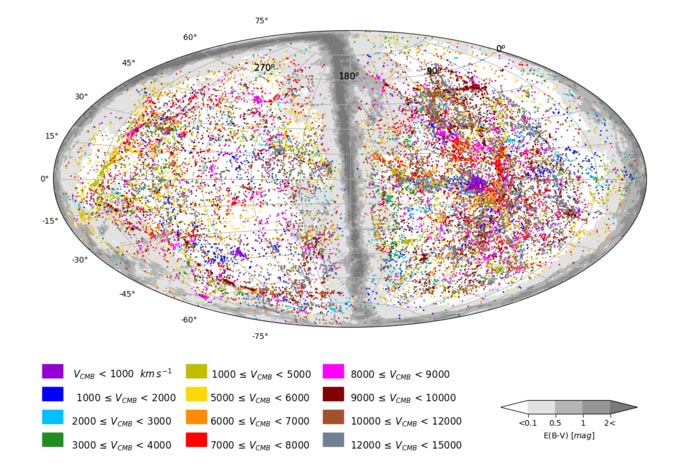Astronomers map distances to 56,000 galaxies

A full-sky map showing Cosmicflows-4’s 56,000 galaxies with distance measurements. Each dot represents a galaxy, and the color of the dot indicates distance from us, with blue tones nearby and redder tones farther away. In this view, the obscuring plane of the Milky Way mostly maps to the edges but also cuts across the center of the figure.
Credit: University of Hawaiʻi
… largest-ever catalog.
How old is our universe, and what is its size? A team of researchers led by University of Hawaiʻi at Mānoa astronomers Brent Tully and Ehsan Kourkchi from the Institute for Astronomy have assembled the largest-ever compilation of high-precision galaxy distances, called Cosmicflows-4. Using eight different methods, they measured the distances to a whopping 56,000 galaxies. The study has been published in the Astrophysical Journal.
Galaxies, such as the Milky Way, are the building blocks of the universe, each comprised of up to several hundred billion stars. Galaxies beyond our immediate neighborhood are rushing away, faster if they are more distant, which is a consequence of the expansion of the universe that began at the moment of the Big Bang. Measurements of the distances of galaxies, coupled with information about their velocities away from us, determine the scale of the universe and the time that has elapsed since its birth.
“Since galaxies were identified as separate from the Milky Way a hundred years ago, astronomers have been trying to measure their distances,” said Tully. “Now by combining our more accurate and abundant tools, we are able to measure distances of galaxies, and the related expansion rate of the universe and the time since the universe was born with a precision of a few percent.”
From the newly published measurements, the researchers derived the expansion rate of the universe, called the Hubble Constant, or H0. The team’s study gives a value of H0=75 kilometers per second per megaparsec or Mpc (1 megaparsec = 3.26 million light years), with very small statistical uncertainty of about 1.5%.
There are a number of ways to measure galaxy distances. Generally, individual researchers focus on an individual method. The Cosmicflows program spearheaded by Tully and Kourkchi includes their own original material from two methods, and additionally
incorporates information from many previous studies. Because Cosmicflows-4 includes distances derived from a variety of independent, distinct distance estimators, intercomparisons should mitigate against a large systematic error.
Cosmic dilemma
Astronomers have assembled a framework that shows the universe’s age to be a little more than 13 billion years old, however a dilemma of great significance has arisen in the details.
Physics of the evolution of the universe based on the standard model of cosmology predicts H0=67.5 km/s/Mpc, with an uncertainty of 1 km/s/Mpc. The difference between the measured and predicted values for the Hubble Constant is 7.5 km/s/Mpc—much more than can be expected given the statistical uncertainties. Either there is a fundamental problem with our understanding of the physics of the cosmos, or there is a hidden systematic error in the measurements of galaxy distances.
Additional studies
Cosmicflows-4 is also being used to study how galaxies move individually, in addition to flowing with the overall expansion of the universe. Deviations from this smooth expansion arise due to the gravitational influences of clumps of matter, on scales ranging from our Earth and Sun up to congregations of galaxies on scales of a half billion light years. The mysterious dark matter is the dominant component on larger scales. With knowledge of the motions of galaxies in response to the mass around them, we can recreate the orbits that galaxies have followed since they were formed, giving us a better understanding of how the universe’s vast, dark-matter dominated structures have formed over the eons of time.
Journal: The Astronomical Journal
Article Publication Date: 26-Sep-2022
Media Contact
Roy Gal
University of Hawaiʻi at Mānoa
roygal@Hawaii.edu
Cell: 808-388-8690
All latest news from the category: Physics and Astronomy
This area deals with the fundamental laws and building blocks of nature and how they interact, the properties and the behavior of matter, and research into space and time and their structures.
innovations-report provides in-depth reports and articles on subjects such as astrophysics, laser technologies, nuclear, quantum, particle and solid-state physics, nanotechnologies, planetary research and findings (Mars, Venus) and developments related to the Hubble Telescope.
Newest articles

Innovative 3D printed scaffolds offer new hope for bone healing
Researchers at the Institute for Bioengineering of Catalonia have developed novel 3D printed PLA-CaP scaffolds that promote blood vessel formation, ensuring better healing and regeneration of bone tissue. Bone is…

The surprising role of gut infection in Alzheimer’s disease
ASU- and Banner Alzheimer’s Institute-led study implicates link between a common virus and the disease, which travels from the gut to the brain and may be a target for antiviral…

Molecular gardening: New enzymes discovered for protein modification pruning
How deubiquitinases USP53 and USP54 cleave long polyubiquitin chains and how the former is linked to liver disease in children. Deubiquitinases (DUBs) are enzymes used by cells to trim protein…


